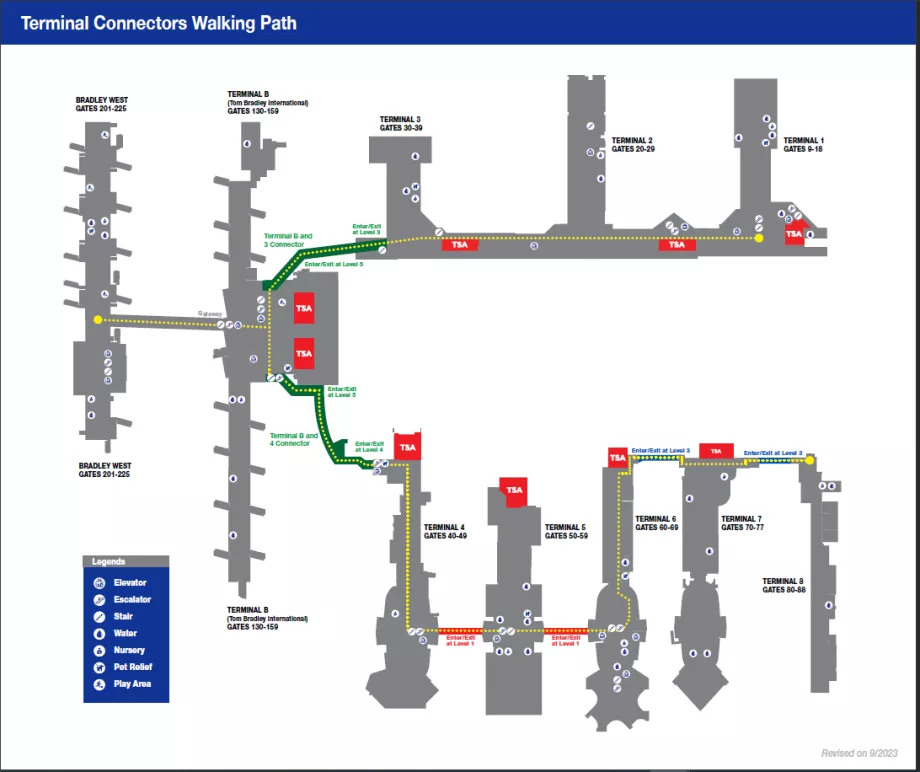Transfer at Los Angeles Airport

LAX uses a total of 9 terminals. All buildings are arranged in a horseshoe-shaped complex around the iconic Theme Building, which houses the observation deck.
Despite its enormous size, the layout of the airport buildings makes it easy to see and the distances between terminals are short.
The terminals are dedicated to specific airlines. Your departure terminal will always be marked on your ticket. All international arrivals take place at Tom Bradley International Terminal (TBIT), which is the only one with immigration control.
However, international departures are split into other terminals as there is no passport control when departing from the USA. Therefore, in some cases, international flights will not be parked at TBIT, where you will be bused across the tarmac upon arrival.
Which terminal?
Which Los Angeles Airport terminal will your flight depart from? For a clear breakdown of all airlines and specific flights, please visit: flylax.com.
- Terminal 1: Air Transat, Allegiant, Breeze Airways, Cayman Airways, Condor, Lynx Air, Norse, Southwest, Sun Country, Viva Aerobus
- Terminal 2: Virgin Atlantic, Westjet
- Terminal 3: AeroMexico, Delta
- Terminal 4: American Airlines (some flights from T5)
- Terminal 5: American Airlines (some flights from T4), JetBlue, Spirit
- Terminal 6: Air Canada, Horizon, Southern Airways Express
- Terminal 7: United (part of flights from T8)
- Terminal 8: United (part of flights from T7)
- Terminal B (TBIT = Tom Bradley International): Aer Lingus, Air France, Air China, Air Premia, Air New Zealand, Air Tahiti Nui, All Nippon Airways, Asiana, Austrian, Avianca, British Airways, Cathay Pacific, China Airlines, China Eastern, China Southern, Copa, El Al, Emirates, Eva Air, Fiji Airways, Finnair, Flair Airlines, FrenchBee, Hainan Airlines, Hawaiian, Iberia, ITA Airways, Japan Air Lines, KLM, Korean Air, LATAM, Level, LOT Polish, Lufthansa, Philippine Airlines, Qantas, Qatar Airways, SAS, Saudia, Sichuan Airlines, Singapore Airlines, Starlux, Swiss, Turkish Airlines, Volaris, Xiamen Airlines, Zipair
In addition to the main building, International Terminal B has a smaller remote building in the middle of the airport area (West Gates), which is connected to the main terminal by an underground corridor with moving walkways.
Terminal 5 also has a remote building in the middle of the apron dedicated to American Eagle flights. From the main terminal 5, departure gates 52B-52I can be reached by a shuttle bus running on the tarmac (approximately every 5 minutes).
Airport map
An interactive map of the entire airport and each terminal can be found on the airport's official website: maps.lawa.org.
Transportation between terminals
Within the "airside" (transit area) and "landside" (public area), all terminals are connected by pedestrian corridors.
However, due to the horseshoe-shaped layout of the buildings, it may be worthwhile to go outside, cross the area and go through security again when moving from certain terminals. This is particularly true when moving from Terminals 1 or 2 to Terminals 5, 6, 7 or 8.
A free shuttle bus also runs between the terminals (approximately once every 5 minutes for 24 hours) via the landside. The shuttle bus stop between the terminals is always marked with a pink sign with a pictogram of the bus.
Transfer between flights
How do I transfer between connecting flights?
Due to its location, LAX is a frequent transfer point when travelling to Hawaii, Oceania, Australia, East Asia or Mexico.
Even though Los Angeles Airport has 9 terminals, transfers are relatively quick and well signposted. If you have to move between terminals, in most cases you'll just have to move to the next building.
What checks do I go through when I transfer?
What are the exact procedures for each type of transfer?
- International -> International: immigration and security check
- International -> domestic: immigration and security check
- National -> International: no check
- National -> national: no check
Do I have to leave the transit zone when transferring between terminals?
If you are arriving in Los Angeles on an international flight, you will always arrive at Terminal B (TBIT). You must exit the transit area, go through immigration and move through the outside area between terminals. You will check in again and go through security into the transit area.
If you are arriving from another destination within the U.S., you can proceed directly to the connecting gate for both domestic and international flights.
Do I need to collect my luggage?
If you are arriving at LAX from abroad, you must always pick up your baggage and resubmit it at the check-in counter.
If you are flying from a destination within the U.S. and you have a layover of no more than 8 hours, your bag will be automatically transferred. It does not matter whether you continue on an international or domestic flight.
Do I need to apply for ESTA?
Every time you transfer from an international flight, you must collect your baggage and exit the transit area.
Therefore, you must have an electronic ESTA to enter the United States (for 21 usd online processing at the official website: esta.cbp.dhs.gov).
How long does the immigration check take?
If you arrive during off-peak hours, you can be in the public section in 20 minutes, but especially during the afternoon rush hour for arrivals from Europe or Asia, the immigration line can be longer than 2 hours.
If you have less than 1.5 hours to transfer, we recommend that you tell the informants that you have a tight transfer before you join the queue. In this case, you may be sent to the priority queue.
If you do not make your guaranteed connection due to the length of the immigration check, the airline will arrange the next flight free of charge. However, accommodation at the airline's expense will not be provided in these cases.
Do I go through passport control on departure?
No. There is no longer an immigration check on departure from the USA.
Any questions left?
If you have any questions or comments about the article...


